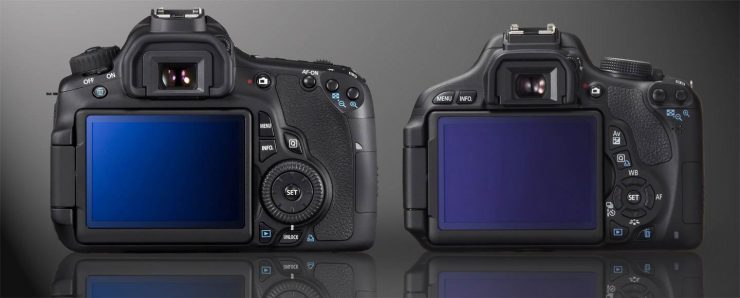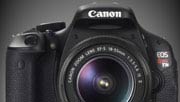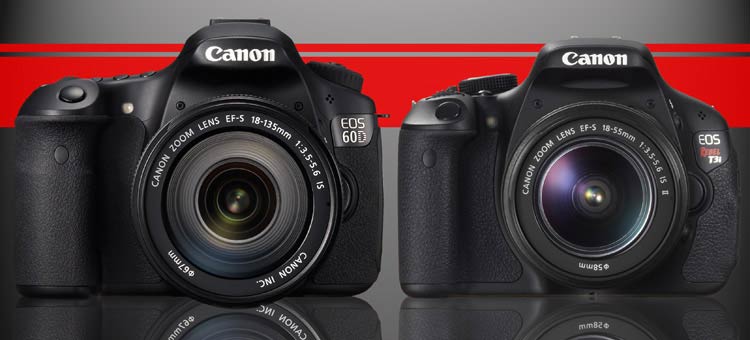Is the Canon 60D Worth the Extra Cost?
Canon T3i vs 60D: The Canon T3i’s release so soon after that of the Canon 60D is cause for speculation. Canon seems to be exploring a fancy new business model in which they release a product and then shortly afterwards announce a similar, less expensive one that also has some slick new features, all but sealing the fate of the earlier product. We saw it happen with the Canon 1Ds Mark III and the subsequent 5D Mark II, then again (to a lesser degree) with the 5D Mark II and the Canon 7D (because of the latter’s superior AF system), with the 50D and subsequent Rebels T1i and T2i, and now it seems that the announcement of the Canon T3i threatens to do the same with the 60D. Let me say before anything else that the Canon 60D is still probably the superior camera, but it may be difficult for most entry level photographers to pass by the T3i to get to it. Let’s take a closer look at the details.
The Canon 60D was released into a market that was already dominated by the popular and inexpensive Canon Rebel T2i / 550D. The 60D, however, had dropped the magnesium alloy body of the 50D and previous x0D series models in favor of a lighter, consumer oriented polycarbonate body. It also sported the same 18 megapixel sensor as the T2i, the same ISO range, the same number of focus points, and the same video capabilities. To the average consumer, the major differences were that the 60D had a spiffy new articulated LCD, a somewhat sturdier feeling body, and slightly faster shooting frame rates and shutter speeds. The 60D also had the often overlooked (by me) advantage of wireless strobe control without the addition of the Canon ST-E2 transmitter.

Enter (4 months later) the Canon Rebel T3i (also known as the 600D). The latest incarnation of the Rebel appears on the scene with the same high resolution, articulated LCD as the 60D, integrated wireless strobe control, new shooting modes, a host of in-camera processing “creative” options, and perhaps most significantly in the video department are cropping mats (to preview different aspect ratios on the LCD while recording) and… digital zoom.
“Digital zoom” has always been a dirty word in the past; we’ve seen it on camcorders and point and shoot digital cameras since the end of the 1990s. Digital zoom traditionally has involved using the same captured information from the sensor and simply cropping in, basically magnifying a lower resolution portion of the frame, which caused a significant degradation of quality. So, if the full sensor captured 1 megapixel, for example, the cropped image might only be displaying a small portion of that information… perhaps .5 or .3 megapixels, but with the pixels enlarged to fill the screen.
The digital zoom of the Canon Rebel T3i is a different story, and it’s actually an ingenious use of the extraordinarily high resolution sensor designed for the still camera. The highest resolution that our HDTVs can display today is 1080p, which is 1920 x 1080 pixels, just a hair over 2 megapixels. The T3i’s sensor, as we know, is 18 megapixels, so even when the highest resolution video is captured, only a small part of the available information from the sensor is being used. Because the sensor has such high resolution, the digital zoom can simply make use of a smaller area of the sensor to capture the video, and there will still be plenty of receptors in the area to provide the full 2 megapixel resolution of 1080p.
Beyond the items mentioned above, the Canon T3i is very much like the T2i, which was already quite similar to the 60D. Take a look at the chart below to see the details:
| Canon Rebel T3i | Canon 60D | Canon Rebel T2i / 550D | |
|---|---|---|---|
 | |||
| Amazon Price (body) | $699 | $999 | $699 |
| B&H Price | $699 | $949 | $629 |
| Body Material | Polycarbonate, Fiberglass and Stainless Steel | Polycarbonate, Aluminum, Fiberglass, and Stainless Steel | Polycarbonate, Fiberglass and Stainless Steel |
| LCD Size / Resolution | 3.0" 1,040,000 pixels | 3.0" 1,040,000 pixels | 3.0" 1,040,000 pixels |
| LCD Articulated? | Yes | Yes | No |
| Sensor Size | 14.9 x 22.3mm (APS-C) | 14.9 x 22.3mm (APS-C) | 14.9 x 22.3mm (APS-C) |
| Crop Factor | 1.6x | 1.6x | 1.6x |
| Sensor Resolution | 18 Megapixels | 18 Megapixels | 18 Megapixels |
| ISO Range | 100-6400 +12800 | 100-6400 +12800 | 100-6400 +12800 |
| Total AF Focus Points | 9 | 9 | 9 |
| Cross-Type AF Sensors | 1 | 9 | 1 |
| AF Light Level Range | -.05 to +18 EV | -.05 to +18 EV | -.05 to +18 EV |
| Metering System | 63 Zone Point Linked Evaluative 9% Center Weighted 4% Spot | 63 Zone Point Linked Evaluative 6.5% Center Weighted 2.8% Spot | 63 Zone Point Linked Evaluative 9% Center Weighted 4% Spot |
| Exposure Compensation | 1/2 or 1/3 stops | 1/2 or 1/3 stops via thumb dial | 1/2 or 1/3 stops |
| Max Frame Rate : RAW (14-bit) | 3.7 | 5.3 fps | 3.7 |
| Max Burst Duration RAW (at highest frame rate) | 6 | 16 | 6 |
| Max Burst Duration JPG (at highest frame rate) | 34 | 58 | 34 |
| Shutter Speed Range | 1/4000th - 30 sec. +bulb | 1/8000th - 30 sec. +bulb | 1/4000th - 30 sec. +bulb |
| Maximum Flash Sync Shutter Speed (standard flash) | 1/200th sec. | 1/250th sec. | 1/200th sec. |
| HD Video Resolutions | 1080p, 720p | 1080p, 720p | 1080p, 720p |
| Available HD Video Frame Rates | PAL and NTSC 24/25, 30 at 1080p 60 at 720p | PAL and NTSC 24/25, 30 at 1080p 60 at 720p | PAL and NTSC 24/25, 30 at 1080p 24/25, 30, 60 at 720p |
| Firmware Sidecar Available | Under Development | Available | Under Development |
| Media Type | SD / SDHC / SDXC | SD / SDHC / SDXC | SD / SDHC / SDXC |
| Weight | 570g (including battery) | 675g (body only) | 530g (with battery and SD card) |
| Viewfinder Coverage | 95% 0.87x magnification | 96% Frame, .95x magnification | 95% 0.87x magnification |
| Built-In Wireless Strobe Control | Yes | Yes | No |
Benefits of the Canon 60D
In opening this article I mentioned that the Canon 60D is still a better camera than the T3i, but I may not have made it obvious in the following paragraphs, so let me explain why.
The Canon 60D will primarily benefit one type of photographer: the action photographer. Although the two cameras in question have the same number of focusing points, the points are not created equal. The T3i, like the T2i, has a single cross-type focusing point in the center, while all 9 of the 60D’s focusing points are cross-type, giving it faster and more reliable AF performance, especially for off-center subjects. To capture high speed objects, the 60D also features a top shutter speed of 1/8000th of a second and top flash sync speed of 1/250th, as opposed to the 1/4000th and 1/200th of the T3i. And while the T3i can capture 3.7 frames per second, the Canon 60D can manage 5.3, giving 60D shooters 3 extra pictures in every 2-second burst.
This is not to suggest that you can’t shoot action with the T3i; you can. You’ll simply have a higher percentage of good shots with the 60D.
I spent much of last evening playing around with a 60D and a T2i (I don’t have access to a T3i yet), and I find that the 60D really does feel significantly better in the hand. It feels solid and comfortable, and it also has the thumb wheel for exposure compensation, probably my favorite Canon feature of all time. Both cameras, however, feel much better than the top point and shoot, though, at least to my fingers. And there is also the fact that 60D shooters don’t have to tolerate having “REBEL” printed across the front of their cameras. How embarrassing for us Americans.
Conclusion
Because the 60D is so precariously perched between the powerhouse Canon 7D and the enormously popular Rebel series (not to mention competition from the Nikon D7000), it’s not surprising that in the few months since it hit the shelves, its price has already dropped from $1100 to $899… just $100 more than the T3i (update 6/18/11: the price has since gone back down to $899 with an instant rebate, but the body only is hard to find in stock). With only $100 difference in price, it seems almost foolish to pass up the 60D, unless:
- you’ve never used a DLSR before and need the beginner features of the T3i (in camera guide and program shooting modes)
- you plan to take a lot of video and really think you’ll use the T3i’s digital zoom or video snapshots
- you primarily shoot portraits, landscapes, or moderate paced action and don’t want to spend $100 on features you won’t use.
You may also want to consider the Rebel T2i if the video features are not important to you (keep in mind that in all three cameras, video is primarily a manual-focus operation (though slow AF is available by pressing the shutter button half-way). If you don’t mind spending a couple hours with the manual, don’t care about an articulated LCD (or are concerned about its durability), the T2i is a virtually identical camera and the body costs a mere $675, at this point.
As usual, please let me know if you have any questions or comments!




